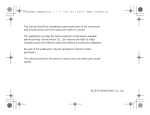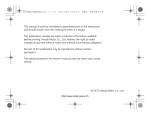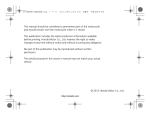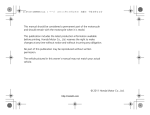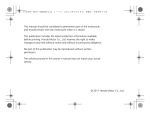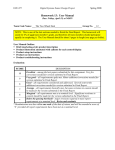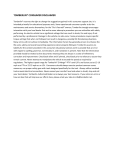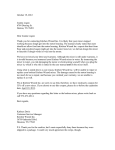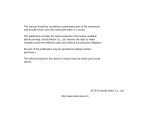Download Homework 13: User Manual Include this sheet as a cover page for
Transcript
ECE 477 Spring 2009 Digital Systems Senior Design Project Homework 13: User Manual Due: Friday, April 24, at NOON Team Code Name: Moto-eV Group No. 13 NOTE: This is one of the last sections needed to finish the Final Report. This homework will count toward each team member’s grade, and therefore all team members should participate equally in completing it. The User Manual should be about 5 pages in length (one page per bullet). User Manual Outline: Brief (marketing-style) product description Product illustration annotated with callouts for each control/display Product setup instructions Product use instructions Product troubleshooting instructions Evaluation: SCORE DESCRIPTION Excellent – among the best papers submitted for this assignment. Very few corrections needed for version submitted in Final Report. Very good – all requirements aptly met. Minor additions/corrections needed for 9 version submitted in Final Report. Good – all requirements considered and addressed. Several noteworthy 8 additions/corrections needed for version submitted in Final Report. Average – all requirements basically met, but some revisions in content should 7 be made for the version submitted in the Final Report. Marginal – all requirements met at a nominal level. Significant revisions in 6 content should be made for the version submitted in the Final Report. Below the passing threshold – major revisions required to meet report * requirements at a nominal level. Revise and resubmit. * Resubmissions are due within one week of the date of return, and will be awarded a score of “6” provided all report requirements have been met at a nominal level. 10 Include this sheet as a cover page for your report ECE 477 Digital Systems Senior Design Project Spring 2009 INTRODUCTION Congratulations on your purchase of the Moto-eV motorcycle. The Moto-eV is a project focused on releasing people from the current dependency on fossil fuels involved with transportation and the harmful emissions that result from fuel combustion. Through the design of a fully electric motorcycle, Moto-eV strives to provide an economical and environmentally friendly form of transportation. IMPORTANT NOTICE • OPERATOR AND PASSENGER This motorcycle is designed to carry the operator and one passenger. Never exceed the maximum weight capacity of 350 lbs. • ON-ROAD USE This motorcycle is designed to be used only on the road. Operation in forest, brush, or grass covered areas may be illegal. Check local laws and regulations. • READ THIS MANUAL CAREFULLY Pay special attention to statements starting with the following words: WARNING Indicates severe personal injury or death will result if instructions not followed. CAUTION Indicates a possibility of personal injury or equipment damage if instructions are not followed. This manual should be considered part of the motorcycle and should remain with it if resold. General Safety Hot Components WARNING • IGBT, motor, batteries, and components on the PCB may get hot during use and remain hot long after the motor has be running. Use insolated gloves or wait till cooled if handling these parts. Electrical Hazards CAUTION • • The batteries are highly dangerous with a possibility of shocking or electrocuting a person if handled improperly. For this reason it is advised not to tamper with the batteries unless recharging. The IGBT located on the electronic mounting plate under the tank contains wires that are connected to the batteries, therefore, highly dangerous with a possibility of shocking or electrocuting a person if handled improperly. For this reason it is advised not to mess with anything under the tank. AS A SINGLE TRACK VEHICLE MOTORCYCLES SAFE USE AND OPERATION DEPENDS ON THE PROPER RIDING TECHNIQUES AND EXPERIENCE OF THE ECE 477 Digital Systems Senior Design Project Spring 2009 OPERATOR. EVERY OPERATOR SHOULD KNOW THE FALLOWING REQUIREMENTS PRIOR TO RIDING THIS MOTORCYCLE: • OBSERVE THE MAINTANENCE REQUIREMENTS AND WARNINGS IN THE OWNERS MANUAL • OBTAIN QUALIFIED TRAINING IN SAFE AND PROPER RIDING TECHNIQUES • OBTAIN INSTRUCTIONS FROM AN ADEQUATE SOURCE OF ALL ASPECTS OF MOTORCYCLE OPERATION Safe Riding • Always make pre-operation checks. Careful checks may prevent an accident. • The motorcycle is designed to carry the operator and one passenger. • Failure of motorist to detect and recognize motorcycles in traffic is a reoccurring cause of automobile/motorcycle accidents. Therefore: o Wear brightly colored jacket. o Use extra caution when approaching or crossing intersections, since intersections are the most likely place for motorcycle accidents. o Ride where motorist can see you, avoid riding in blind spots. • Many accidents involve inexperienced operators of those many of the operators do not possess a current motorcycle license. o Make sure that you are certified and only lend your motorcycle of to others who are certified to use it. o Know your limitations and skill leave and ride within those to help avoid accidents. • The lean angle is not meant to be used as a means of competition. Therefore do not try to decrease you angle. • The posture of operator and passenger is important for proper control. o The operator should keep both hands on the handle bars and both feet on the footrest during operation. o The passenger should always hold on to the operator or grab bar with both hands and have both feet on the passenger’s footrest. o Never carry a passenger unless both of their feet can rest firmly on the footrest. • Never ride under the influence of alcohol or drugs. • This motorcycle is designed for on road use only and is not suitable for off-road use. Protective Apparel The majority of all motorcycle fatalities are due to head injury for this reason the use of a helmet is critical for prevention or reduction of head injuries. • Always wear an approved helmet. • Wear a riding jacket, gloves, boats, and pants would help prevent or reduce abrasions or lacerations. • Wear a face shield, goggles, or glasses when riding. Wind in the eyes could cause visual impairment. • Avoid wearing loose or baggy clothing. They could get caught on something causing injury or an accident. • The passenger should also fallow all of the above precautions. ECE 477 Digital Systems Senior Design Project Your New Moto-eV Electric Motorcycle Guide Spring 2009 ECE 477 Digital Systems Senior Design Project Spring 2009 ECE 477 Digital Systems Senior Design Project Spring 2009 ECE 477 Digital Systems Senior Design Project Spring 2009 ECE 477 Digital Systems Senior Design Project Spring 2009 How to Operate the Moto-eV The Moto-eV is intended to be used as a single passenger, short range commuting vehicle. The rider should wear the protective gear as advised above, at all times. Sitting on the seat, the rider uses his right wrist to rotate the throttle. This will adjust the amount of power delivered to the rear wheel. The right fingers should be used to operate the front brake. The right foot is used to operate the rear brake. There are a total of three toggle switches located on the dash of the bike. The switch furthest to the right turns the LCD backlight on and off. The switch just to the left of the previous switch is used to control which information the LCD displays. The switch furthest to the right toggles between the two ride modes. A rider should periodically check the information displayed on the dash and on the LCD. Critical speed, current pull, and battery charge levels are displayed on these two devices. Ride mode one is with the toggle switch in the down position. This mode limits the amount of current the motor can pull. The results are slower acceleration, but greater range per charge. Ride mode two is the higher performance mode. This mode puts a higher limit on the current, and should be used when quicker acceleration is desired. Product Setup & Use Powering On the Vehicle 1. Turn the ignition key to the on position. 2. Turn the battery pack key to the on position. 3. Ensure that the LCD boots up. Maneuvering the Vehicle 1. Use the handlebars to control direction. 2. Use the throttle and front & rear brakes to control speed. Powering Off the Vehicle 1. Safely bring the vehicle to a stop and dismount. 2. Turn the battery pack key to the off position. 3. Turn the ignition key to the off position. Recharging the Micro-Battery 1. Ensure that the bike is in a covered area. 2. Remove the seat using the two levers on either side of the bike. 3. Turn the charge switch to the “charge” state (towards the left side of the bike). 4. Plug in the main power cord to a 120V AC wall outlet. a. NOTE: This will charge the main battery pack at the same time! 5. Monitor the LED on the top of the charger. Red indicates charging while green indicates a full charge. 6. Once the charger displays a full charge, switch the charge switch to the off position (towards the right side of the bike). a. IF THIS STEP IS NOT TAKEN THE MICRO-BATTERY WILL CHARGE ANYTIME THE MAIN BATTERY PACK IS CHARGED! 7. Disconnect the main power cord and reinstall the seat. 8. Ensure that the main power cord is properly stowed within the bike. ECE 477 Digital Systems Senior Design Project Spring 2009 Recharging the Power Battery Pack 1. Ensure that the bike is in a covered area. 2. Plug the main power cord into a standard 120V AC wall outlet. 3. The charge status of only battery 4 can be monitored using the small LED on the side of the charger. Under normal operating conditions the batteries should discharge at the same rate. Red indicates charging while green indicates a full charge. 4. Battery level can also be monitored by turning on the ignition and viewing the voltage levels on the LCD. 5. Once the charger LED shows a full charge disconnect the main power cord. 6. Ensure that the main power cord is properly stowed within the bike. Storage 1. Ensure that both the ignition and the battery pack are in the off position. 2. Be sure to maintain a charge on the batteries. 3. If the center stand is installed, use it to prevent tire fatigue. Disposal 1. Take vehicle to a technician for disassembly. a. Certain parts are recyclable and others are not. b. DO NOT ATTEMPT TO DISASSEMBLE! Product Troubleshooting Problem Turning ignition key does not power on micro. Possible Cause 1. Low micro battery 2. Blown fuse Turning throttle does not turn rear wheel 1. Low power batteries 2. Broken throttle 3. Blown IGBT 4. Blown gate driver LCD does not display any data 1. Blown LCD Headlight or brakelight do not illuminate Poor vehicle performance Lean angle is not displaying correctly 1. Blown bulbs 1. Low power batteries 2. Max vehicle weight exceeded 1. Inclinometer failure Solution 1. Recharge micro battery 2. Replace fuse with a fuse of the same rating 1. Recharge battery pack 2. Take vehicle to authorized technician 3. Take vehicle to authorized technician 4. Take vehicle to authorized technician 1. Take vehicle to authorized technician for part replacement 1. Replace parts with same or equivalent models 1. Recharge battery pack 2. Ensure that the maximum cargo & rider weight has not been exceeded 1. Take vehicle to authorized technician for part replacement









